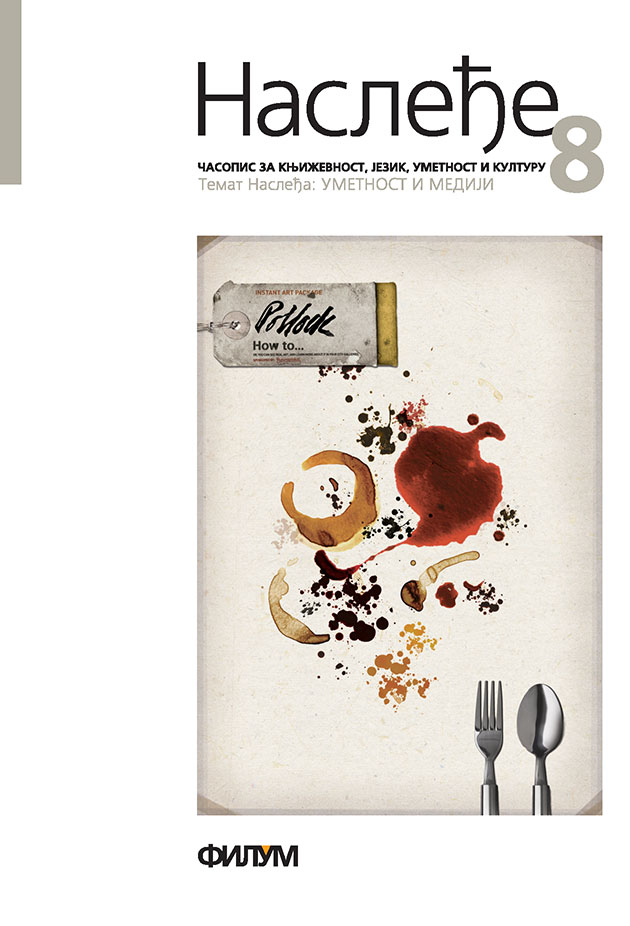HEARKENING THE AVANT-GARDE NOT YET EXPENDED: DANIL HARMS IN THE RADIOPHONIA OF BELGRADE AUTHORS
Keywords:
авангарда, атематичност, пост-заум, пародирање, радиофонија, театар апсурда, звукAbstract
The narrative structures of Harms’s literary utterance assume the existence of the sound/musical signs, which is why it is possible that his opus be perceived according to the principles of analyzing a piece of musical work. Suchlike interpretation of sign procedures is nevertheless necessary in attaining the semiotic radiophonic competence given the fact that The Eighth Art, virtually without any exception, resides within the forms borrowed from the art of music domain. The quality of radiophony attributed to Harms’s Theatre of the Absurd lies in the word/sound exposure – thus his plays sound. Danil Harms (Daniil Kharms) frequently resorts to classical music forms while conceptualizing his text – Symphony, Passacaglia, Suite. We also recognize the influences of the folk music tradition of Russia. In accordance with Harms’s “time ever presence”,the elements of future tendencies are to be heard – of the author of the minimalist period, of the postmodernism era. Baroque dynamics represents an indispensable drama element of Harms’s theatrical plays. Like the voices in chorus fugue, the contrapuntal line forming provides continuity being melodiously harmonious, for interruption of any kind would entail the termination of existence, “I pause to socialize with you. Over.” The latter style of composing may be compared with neobaroque tendencies present during the very times when Harms created his work of art. His exhilaration by classical patterns Harms was to demonstrate in the most present form of the epoch, sonata cycle, while, in an endeavor to achieve the continuity of stating his (a)thematic material, romanticism was to be present only in the cyclic principle. Being in an antiromantic mood, he embarked upon a complex reinterpretation of traditional performance and attained the expressionism of Shenbergerian and Webernian style. Like Shenberger, Harms as well advocates dissonance emancipation, atonality and its subsequent serial systematization; he depersonalizes his characters by transforming them into the speaking “sound shells”. He comminutes and decomposes their language to the point of the latter becoming points of the Webern punctualism (pointlism). The aphoristic manner of expression is also retained by means of (sort to speak) more comprehensive structures. Parody represents Harms’s favourite composing pattern: in the style of opera, popular theatre, conventional thought. He demonstrates his intention of employing the most frequently exploited cadences in order to subsequently postpone their resolution by means of the elliptic serial variation (perhaps those of a dodecaphonic kind) reaching and even exceeding the limits of endurance of The Reader. His aleatoric utterance allows additional text and free/randomized text dislocation which the authors of the Belgrade school were to exploit in profusion. Deliberating on the performance of Emil Giles at Literary Club in Leningrad on February 19th 1939, he disintegrated – doing it unconsciously perhaps – the foundations of music drama in his theatrical plays and stage miniatures. This manual for reading the “black miniaturist” was to be most explicitly exposed in the radiophonic manuscript by Petar Teslić – when staging Elizaveta Bam in 1977, the key text of the Theatre of the Absurd and post-transrational (in the original: postzaumni) music language of Danil Harms (though other radiophonic works of the Belgrade Radio programme are briefly analyzed as well, such as: Četvrtina dima, Slučajevi, Vanja i Lenočka pišu priče i Smetnja (English: Quarter of the Smoke, Cases, Vanja and Lenočka are writing stories and Intereference). We hereby insist on Elizaveta Bam since it represents the key text of the “OBERIU theatre” as well as the entire opus of Danil Harms, bearing on mind the fact that it is fundamentally related to the radiophonic poetics. The director Petar Teslić did not take Harms’s essay/critique of Giles’s concert into consideration when conceptualizing Elizaveta Bam. Nevertheless, the approaches are practically identical. Elizaveta Bam (or “the doom of the citizens theatre” as cited in the subtitle of the radiophonic version) is, in both cases, constructed according to hybrid formula – rhapsodic forms and the baroque perpetuum within athematical variational procedure of dodecaphonic serial displays – beats. Both the composer and the director, it seems, elaborate on the absurd/athematic guilt motif of the committed crime in a simultaneously hilarious and frightening genre alteration. The abundance of sound/musical traits makes Harms’s text ideal for the latter to be translated into the radiophonic space. Likewise, his art, the tool of which is to be found in the absurd that he employs in order to execute a detailed inventory/removal of anything that is an imitation of art, is still contemporary almost eight decades after, since, instead of identification, it starts from the negation…
References
2. D anuser, Hermann: „Arnold Schonberg – Portrait of a Century“, Arnold Schonberg Center 1998, http://www.schonberg.at
3. Појмовник руске авангарде, свеска бр. 3, 7, 8, Графички завод Хрватске, Загреб 1990.
4. Difference de qualite, Danil Harms (izbor i prevod Vladimir Gerić), Izdavački centar Revija Osijek, Osijek, 1983.
5. Gordon, Mel: „Songs from the Museum of Future: Russian Sound Creation (1910-1930)“, Wireless Imagination, Sound, Radio and the Avant-garde, Douglas Kahn et al, The MIT Press, Cambridge Massachusetts, 1992.
6 Данил Хармс, Градац бр. 146-147, 2002.
7. Хармс, Данил: Случајеви (превод Дејан Михаиловић), Рад, Београд, 1995.
8. Хлебњиков, Велимир: Обијање Васељене (превод Злата Коцић), Рад, Београд, 1998.
9. Јохансен/Ларсен: „Код и структура: од разлике ка значењу“, Увод у семиотику (превео са енглеског Стипе Гргас), CroatiaLiber, Загреб, 2000.
10. Јокић, Мирослав: Очаравање ува“, Универзитет БК, Академија уметности, Београд 2000.
11. Јокић, Мирослав: Радиофонијски простор, РТС Радио Београд, Београд, 2002.
12. Јокић, Мирослав: Историја радиофоније, рукопис.
13. Луис, Керол: Алиса у земљи иза огледала (превод Луке Семеновића), Младо покољење, Београд, 1964.
14. Лунц, Лав: Мајмуни долазе, Рад, Београд, 1990.
15. Хармс, Данил: Случајеви (избор, превод и предговор Дејан Михаиловић), Знак, Београд, 1982.
16. Паунковић, Зорислав: „Лав Лунц“, Мајмуни долазе, Рад, Београд, 1990.
17. Piccon-Vallin, Beatrice: „Foreggerova radionica (atelier) i komična struja u sovjetskom teatru“, Sovjetska kazališna avangarda (priredio Branimir Donat), CEKADE, Zagreb, 1985.
18. Shawn, Allen: Arnold Schoenberg’s Journey, Harvard University Press, Cambridge Massachusetts, 2002.
19. Шуваковић, Мишко: Постмодерна (73 појма), Народна књига/Алфа, Београд 1995.






